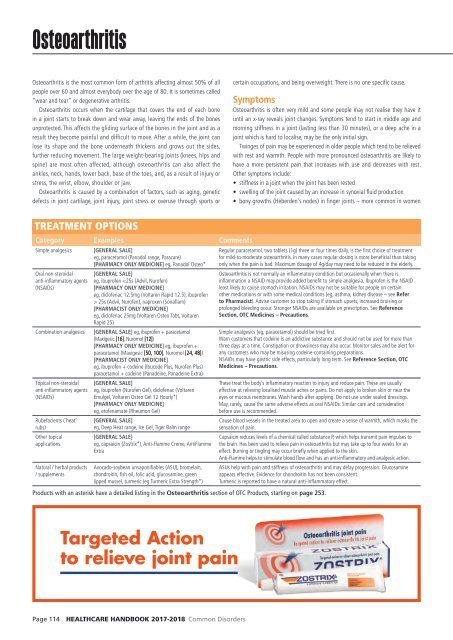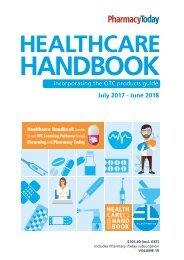2017 HCHB_digital
Create successful ePaper yourself
Turn your PDF publications into a flip-book with our unique Google optimized e-Paper software.
Osteoarthritis<br />
Osteoarthritis is the most common form of arthritis affecting almost 50% of all<br />
people over 60 and almost everybody over the age of 80. It is sometimes called<br />
"wear and tear" or degenerative arthritis.<br />
Osteoarthritis occurs when the cartilage that covers the end of each bone<br />
in a joint starts to break down and wear away, leaving the ends of the bones<br />
unprotected. This affects the gliding surface of the bones in the joint and as a<br />
result they become painful and difficult to move. After a while, the joint can<br />
lose its shape and the bone underneath thickens and grows out the sides,<br />
further reducing movement. The large weight-bearing joints (knees, hips and<br />
spine) are most often affected, although osteoarthritis can also affect the<br />
ankles, neck, hands, lower back, base of the toes, and, as a result of injury or<br />
stress, the wrist, elbow, shoulder or jaw.<br />
Osteoarthritis is caused by a combination of factors, such as aging, genetic<br />
defects in joint cartilage, joint injury, joint stress or overuse through sports or<br />
certain occupations, and being overweight. There is no one specific cause.<br />
Symptoms<br />
Osteoarthritis is often very mild and some people may not realise they have it<br />
until an x-ray reveals joint changes. Symptoms tend to start in middle age and<br />
morning stiffness in a joint (lasting less than 30 minutes), or a deep ache in a<br />
joint which is hard to localise, may be the only initial sign.<br />
Twinges of pain may be experienced in older people which tend to be relieved<br />
with rest and warmth. People with more pronounced osteoarthritis are likely to<br />
have a more persistent pain that increases with use and decreases with rest.<br />
Other symptoms include:<br />
• stiffness in a joint when the joint has been rested<br />
• swelling of the joint caused by an increase in synovial fluid production<br />
• bony growths (Heberden's nodes) in finger joints – more common in women<br />
TREATMENT OPTIONS<br />
Category Examples Comments<br />
Simple analgesics<br />
Oral non-steroidal<br />
anti-inflammatory agents<br />
(NSAIDs)<br />
Combination analgesics<br />
Topical non-steroidal<br />
anti-inflammatory agents<br />
(NSAIDs)<br />
Rubefacients (‘heat’<br />
rubs)<br />
Other topical<br />
applications<br />
Natural / herbal products<br />
/ supplements<br />
[GENERAL SALE]<br />
eg, paracetamol (Panadol range, Paracare)<br />
[PHARMACY ONLY MEDICINE] eg, Panadol Osteo*<br />
[GENERAL SALE]<br />
eg, ibuprofen 25s (Advil, Nurofen), naproxen (Sonaflam)<br />
[PHARMACIST ONLY MEDICINE]<br />
eg, diclofenac 25mg (Voltaren Osteo Tabs, Voltaren<br />
Rapid 25)<br />
[GENERAL SALE] eg, ibuprofen + paracetamol<br />
(Maxigesic [16], Nuromol [12])<br />
[PHARMACY ONLY MEDICINE] eg, ibuprofen +<br />
paracetamol (Maxigesic [50, 100], Nuromol [24, 48])<br />
[PHARMACIST ONLY MEDICINE]<br />
eg, ibuprofen + codeine (Ibucode Plus, Nurofen Plus)<br />
paracetamol + codeine (Panadeine, Panadeine Extra)<br />
[GENERAL SALE]<br />
eg, ibuprofen (Nurofen Gel), diclofenac (Voltaren<br />
Emulgel, Voltaren Osteo Gel 12 Hourly*)<br />
[PHARMACY ONLY MEDICINE]<br />
eg, etofenamate (Rheumon Gel)<br />
[GENERAL SALE]<br />
eg, Deep Heat range, Ice Gel, Tiger Balm range<br />
[GENERAL SALE]<br />
eg, capsaicin (Zostrix*), Anti-Flamme Creme, AntiFlamme<br />
Extra<br />
Avocado-soybean unsaponifiables (ASU), bromelain,<br />
chondroitin, fish oil, folic acid, glucosamine, green<br />
lipped mussel, turmeric (eg Turmeric Extra Strength*)<br />
Regular paracetamol, two tablets (1g) three or four times daily, is the first choice of treatment<br />
for mild-to-moderate osteoarthritis. In many cases regular dosing is more beneficial than taking<br />
only when the pain is bad. Maximum dosage of 4g/day may need to be reduced in the elderly.<br />
Osteoarthritis is not normally an inflammatory condition but occasionally when there is<br />
inflammation a NSAID may provide added benefit to simple analgesia. Ibuprofen is the NSAID<br />
least likely to cause stomach irritation. NSAIDs may not be suitable for people on certain<br />
other medications or with some medical conditions (eg, asthma, kidney disease – see Refer<br />
to Pharmacist). Advise customer to stop taking if stomach upsets, increased bruising or<br />
prolonged bleeding occur. Stronger NSAIDs are available on prescription. See Reference<br />
Section, OTC Medicines – Precautions.<br />
Simple analgesics (eg, paracetamol) should be tried first.<br />
Warn customers that codeine is an addictive substance and should not be used for more than<br />
three days at a time. Constipation or drowsiness may also occur. Monitor sales and be alert for<br />
any customers who may be misusing codeine-containing preparations.<br />
NSAIDs may have gastric side effects, particularly long term. See Reference Section, OTC<br />
Medicines – Precautions.<br />
These treat the body’s inflammatory reaction to injury and reduce pain. These are usually<br />
effective at relieving localised muscle aches or pains. Do not apply to broken skin or near the<br />
eyes or mucous membranes. Wash hands after applying. Do not use under sealed dressings.<br />
May, rarely, cause the same adverse effects as oral NSAIDs. Similar care and consideration<br />
before use is recommended.<br />
Cause blood vessels in the treated area to open and create a sense of warmth, which masks the<br />
sensation of pain.<br />
Capsaicin reduces levels of a chemical called substance P, which helps transmit pain impulses to<br />
the brain. Has been used to relieve pain in osteoarthritis but may take up to four weeks for an<br />
effect. Burning or tingling may occur briefly when applied to the skin.<br />
Anti-Flamme helps to stimulate blood flow and has an anti-inflammatory and analgesic action.<br />
ASUs help with pain and stiffness of osteoarthritis and may delay progression. Glucosamine<br />
appears effective. Evidence for chondroitin has not been consistent.<br />
Turmeric is reported to have a natural anti-inflammatory effect.<br />
Products with an asterisk have a detailed listing in the Osteoarthritis section of OTC Products, starting on page 253.<br />
Targeted Action<br />
to relieve joint pain<br />
Page 114 HEALTHCARE HANDBOOK <strong>2017</strong>-2018 Common Disorders



